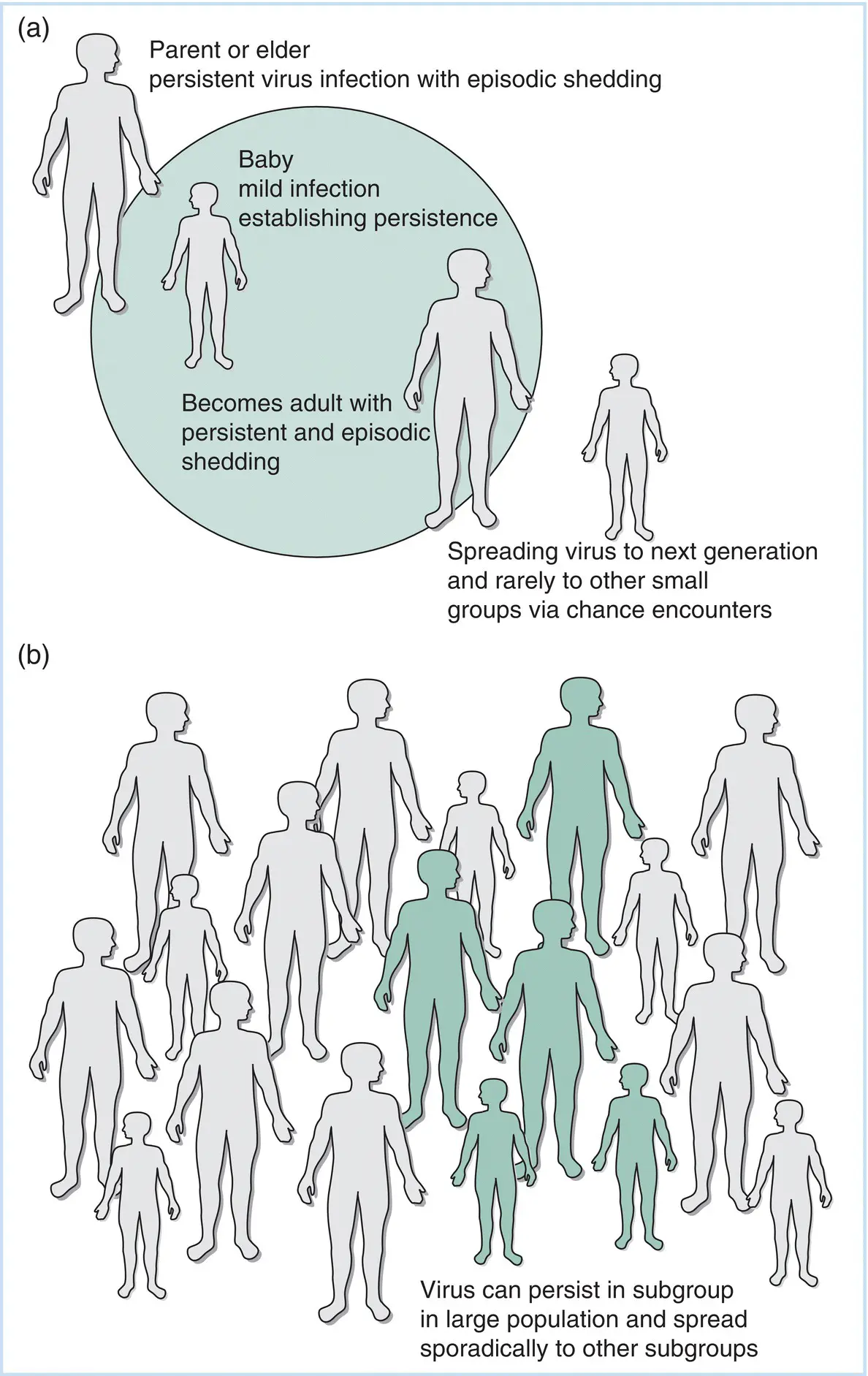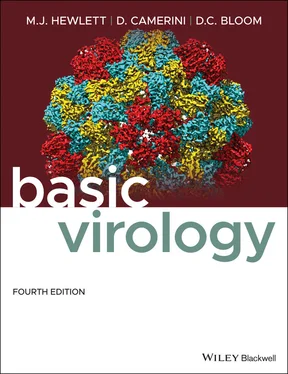Martinez J. Hewlett - Basic Virology
Здесь есть возможность читать онлайн «Martinez J. Hewlett - Basic Virology» — ознакомительный отрывок электронной книги совершенно бесплатно, а после прочтения отрывка купить полную версию. В некоторых случаях можно слушать аудио, скачать через торрент в формате fb2 и присутствует краткое содержание. Жанр: unrecognised, на английском языке. Описание произведения, (предисловие) а так же отзывы посетителей доступны на портале библиотеки ЛибКат.
- Название:Basic Virology
- Автор:
- Жанр:
- Год:неизвестен
- ISBN:нет данных
- Рейтинг книги:3 / 5. Голосов: 1
-
Избранное:Добавить в избранное
- Отзывы:
-
Ваша оценка:
- 60
- 1
- 2
- 3
- 4
- 5
Basic Virology: краткое содержание, описание и аннотация
Предлагаем к чтению аннотацию, описание, краткое содержание или предисловие (зависит от того, что написал сам автор книги «Basic Virology»). Если вы не нашли необходимую информацию о книге — напишите в комментариях, мы постараемся отыскать её.
The basics of virology Virological techniques Molecular biology Pathogenesis of human viral disease The 4th edition includes new information on the SARS, MERS and COVID-19 coronaviruses, hepatitis C virus, influenza virus, as well as HIV and Ebola. New virological techniques including bioinformatics and advances in viral therapies for human disease are also explored in-depth. The book also includes entirely new sections on metapneumoviruses, dengue virus, and the chikungunya virus.
Basic Virology — читать онлайн ознакомительный отрывок
Ниже представлен текст книги, разбитый по страницам. Система сохранения места последней прочитанной страницы, позволяет с удобством читать онлайн бесплатно книгу «Basic Virology», без необходимости каждый раз заново искать на чём Вы остановились. Поставьте закладку, и сможете в любой момент перейти на страницу, на которой закончили чтение.
Интервал:
Закладка:
These two basic, non‐exclusive strategies of virus replication are diagrammed in Figure 4.1. Of course, not all viruses are constrained by their narrow host rangeto infect just one species or type of host. Some, notably a number of viruses using RNA as their genetic material, have a broad host rangeand can readily jump from one species of host to another. With such a virus, the constraints on the mortality of the disease caused in the novel or ancillary host target population are counterbalanced by less severe disease and therefore persistence in a different species that the virus infects. It is not particularly surprising, then, that mortality rates of some diseases caused by zoonotic viruses are quite high.

Figure 4.1 Virus maintenance in small and large populations. (a) In a small population, virus infection can only occur when there is an immunologically naive individual available. This requires a virus within such a population to be able to maintain itself in an infectious state in individuals long after they have been infected. A favored mode of infection would be from parent to child. Clearly, high mortality rates or severe disease symptoms would be selected against. (b) In a large population, there will be a large number of susceptible individuals appearing at the same time. This can result in local episodic infections of such individuals. The large size of the host population insures that some virus is available from actively infected adults at all times. While persistence is not excluded, it need not be strongly selected for, especially if the course of the acute phase of the disease is relatively long compared to the generation time of the population.
Other factors further complicate the simple patterns of virus infection and persistence outlined here. A notable one is that if the period of time between the initial infection and the appearance of symptoms (the incubation period) is longer than the generation time of the host, constraints on mortality are lost. This is the case for rabies, which exhibits essentially a 100% mortality rate in infected carnivores – its natural host – but has a very long incubation period that allows reproduction even after infection. The lifespan of humans is so long that this might not seem to be a major factor in maintaining virus infections with high mortality rates, but the association between certain persistent human virus infections and the very much later appearance of tumors and immuno‐pathologies is a consequence of a long incubation period between initial infection and ultimate pathology.
Classification of human disease–causing viruses according to virus–host dynamics
We can use the nature of the virus–host interaction to generate a simple classification of viruses, especially those of humans. These criteria are a useful aid for organizing detailed information concerning diseases with a viral etiologywithin the context of possible courses and outcomes. A number of specific examples are outlined in this chapter.
Some of the basic criteria that can be incorporated into such a scheme include:
1 Do the symptoms of the viral disease take a short or long time to develop after first encountering the virus?
2 Are the symptoms of initial infection relatively mild or severe?
3 Can the infected individual be expected to recover completely, or partially?
4 Does the virus stay associated with the victim following apparent recovery?
5 If the association is lasting, is the virus maintained in an infectious form either sporadically or constantly?
Viral diseases leading to persistence of the virus in the host are generally associated with viruses having long associations with human populations
Humans, like other animals, are subject to numerous viral infections mediated by viruses either maintained solely in the host population or in another population of animals with which humans interact. We have seen that two basic patterns occur in the course of virus replication in humans – persistent infections with incomplete virus clearing, and acute infections with efficient virus clearing upon recovery from the acute infection. It might be argued that persistent infections represent associations between virus and host that have stabilized over time, such that the viruses are maintained within the host population without a large negative effect. Conversely, acute infections may involve viruses that have recently moved from a different host. In the case of humans, such viruses may originate from zoonotic infections. While influenza A viruses and hantaviruses are examples that support this model, human rhinoviruses, among others, would not, since there are no known animal reservoirs. These virus groups and some of the symptoms caused by their infections of humans are listed in Table 4.1.
Table 4.1 Some viruses infecting humans.
| Family | Genome | Primary Reservoir | How Long Associated with Humans | Virus Type | Acute Disease | Primary Infection | Mortality Rate | Persistent/Latent? | Reactivation | Chronic Disease/Complications |
|---|---|---|---|---|---|---|---|---|---|---|
| Herpesviridae | DNA | Humans | Ancient | HSV‐1 | Facial lesion | Epidermis | Nil | Yes | Frequent at site | Encephalitis (rare) |
| HSV‐2 | Genital lesion | Epidermis | Nil | Yes | Frequent at site | Encephalitis (rare) | ||||
| VZV | Chickenpox | Epidermis | Nil | Yes | Once | Shingles/disseminated infection upon immune suppression | ||||
| HCMV | Mononucleosis | Hematopoietic tissue | Nil | Yes | Asymptomatic/infrequent? | Disseminated infection upon immune suppression/retinitis | ||||
| EBV | Mononucleosis | Lymphoid tissue | Nil | Yes | Asymptomatic/infrequent? | Lymphoma/carcinoma | ||||
| HHV‐6 | Roseola | Lymphoid tissue | Nil | Yes | Asymptomatic/infrequent? | ? | ||||
| HHV‐7 | Roseola | Lymphoid tissue | Nil | Yes | Asymptomatic/infrequent? | ? | ||||
| HHV‐8 | ? | Lymphoid tissue | Nil | Yes | Asymptomatic/infrequent? | Kaposi's sarcoma | ||||
| Polyomaviridae | DNA | Humans | Ancient | JC | None | Kidney/bladder | Nil | Yes | Infrequent (?) shedding | Encephalitis upon immune suppression |
| BK | None | Kidney/bladder | Nil | Yes | Infrequent (?) shedding | Kidney infection | ||||
| Papillomaviridae | DNA | Humans | Ancient | >60 types | Warts | Epidermis | Nil | Yes | Constant shedding at site | Cervical carcinoma (Types 6, 11, 16, and 18) |
| Adenoviridae | DNA | Humans | Ancient? | >12 types | Mild respiratory | Respiratory tract | Nil | Yes | Infrequent shedding? | ? |
| Poxviridae | DNA | Humans | Recent | Variola | Smallpox | Epidermis | Moderate to high | No | N/A | None |
| Orthomyxoviridae | RNA | Birds, pigs | Sporadic/current | Influenza A | Influenza | Respiratory tract | Usually low/rarely high | No | N/A | None |
| Humans | Sporadic/current | Influenza B | Influenza | Respiratory tract | Nil | None | ||||
| Coronaviridae | RNA | Humans | ? | Human coronavirus | Cold | Nasopharynx | Nil | No? | N/A | None |
| Palm civets | Current | SARS | Acute respiratory failure | Respiratory tract | Moderate to high | No | N/A | None | ||
| Picornaviridae | RNA | Humans | Recent? | Poliovirus | None to mild digestive upset | GI tract | Nil | No | N/A | Paralysis |
| Humans | Recent? | Hepatitis A virus | Hepatitis | Liver | Low | No | N/A | Rare | ||
| Humans | ? | Rhinoviruses | Cold | Respiratory tract | Nil | No? | N/A | None | ||
| Hepeviridae | RNA | Human | ? | Hepatitis E | Hepatitis; severe in newborns | Liver | Nil, except pregnant women; moderate in newborns | No | N/A | Rare |
| Flaviviridae | RNA | Birds | Sporadic/current | West Nile | Encephalitis | Brain | Low | No | N/A | Neurological |
| Primates | Sporadic/current | Yellow fever | Encephalitis | Brain | Moderate | No | N/A | Neurological | ||
| Human | ? | Hepatitis C virus | Hepatitis | Liver | Low | Occasional | Chronic hepatitis with no virus shedding | Liver failure/carcinoma | ||
| Human | Sporadic/current | Dengue | Fever/joint pain | Leukocytes | Low | No | N/A | Hemorrhagic fever | ||
| Human/primate | Sporadic/current | Zika | Fever/joint pain/rash | ? | Low | No? | N/A | Neurological, teratogen | ||
| Rhabdovirus | RNA | Carnivores | Sporadic/current | Rabies | Encephalitis | Brain | 100% | No | N/A | N/A |
| Togavirus | RNA | Horses | Sporadic/current | Equine encephalitis virus | Encephalitis | Brain | Low | No | N/A | Neurological |
| Human? | ? | Rubella virus (German measles) | Rash | Skin/developing nerve tissue | Nil in adults; severe neurological symptoms in developing fetus | No | N/A | Fetal infection | ||
| Paramyxovirus | RNA | Carnivore? | Recent | Measles | Rash | Respiratory tract | Low/moderate | Yes/no | Chronic virus antigen present/no infectious virus | SSPE |
| Human | ? | Mumps | Glandular inflammation | Respiratory tract | Nil | No | N/A | Infertility | ||
| ? | ? | Respiratory syncytial virus | Mild respiratory in adults | Nasopharynx | Nil in adults | Yes | Virus shed from nasopharynx | Infections of newborns | ||
| Hepatitis delta | RNA | Human | ? | Hepatitis D | Hepatitis | Liver | Usually low, but infection with hepatitis B leads to acute liver failure | Yes | Virus antigen present and infectious in blood | Liver failure |
| Bunyavirus | RNA | Mosquitoes | ? | Lacrosse encephalitis virus | Encephalitis | CNS | Low; more severe for children | No | N/A | None |
| Rodents | ? | Hantavirus | Severe respiratory failure | Respiratory tract | Moderate, especially in young adults | No | N/A | Respiratory failure | ||
| Hepadnavirus | RNA/DNA | Human | ? | Hepatitis B | Hepatitis | Liver | Low | Yes | Virus antigen present and infectious in blood | Liver failure/carcinoma |
| Retrovirus/RNA tumor virus | RNA/DNA | Humans | Ancient | Human T‐cell leukemia | None | Lymphoid tissue | Nil? | Yes | Infectious virus shed? | Lymphoma/paraparesis |
| Retrovirus/lentivirus | RNA/DNA | Chimpanzees/mangabeys | 1930 ± 20 years/? | HIV‐1/HIV‐2 | None/flu‐like or mononucleosis‐like | Lymphoid tissue | 100% | Yes | Infectious virus shed | Immunodeficiency |
A number of important human viruses are either asymptomatic or cause relatively mild symptoms of primary infection, which is followed by a stable association between virus and host that lasts as long as the latter lives. During this more or less stable association, some viruses are constantly shed, while persistent infections with others lead to loss of any detectable virus. In the latter case, various types of stress to the host can lead to viral recrudescence(reappearance of infectious virus along with mild or no symptoms) with the potential for virus spread to other individuals.
Читать дальшеИнтервал:
Закладка:
Похожие книги на «Basic Virology»
Представляем Вашему вниманию похожие книги на «Basic Virology» списком для выбора. Мы отобрали схожую по названию и смыслу литературу в надежде предоставить читателям больше вариантов отыскать новые, интересные, ещё непрочитанные произведения.
Обсуждение, отзывы о книге «Basic Virology» и просто собственные мнения читателей. Оставьте ваши комментарии, напишите, что Вы думаете о произведении, его смысле или главных героях. Укажите что конкретно понравилось, а что нет, и почему Вы так считаете.












